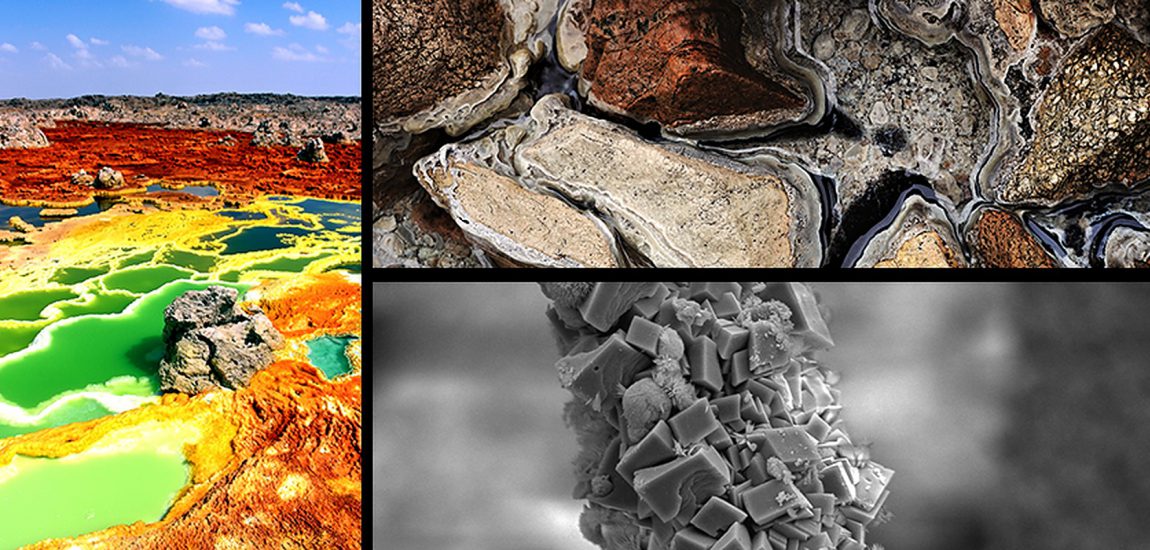
Announcing the winners of the Photo Contest ‘Wonders of Geochemistry’
We are pleased to announce the winners of the 2017 Photo Contest ‘Wonders of Geochemistry’. Of the final ten photos selected by our jury, the following three received the highest number of votes. Many thanks to all who submitted entries, to all who cast votes, and many congratulations once more to our three winners!
We asked the photographers to tell us more about their winning pictures so read on to find out the stories behind these images, which capture beautifully some of the ‘Wonders of Geochemistry’.
'The color palette of Dallol' by Electra Kotopoulou
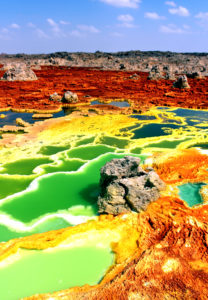
The Danakil depression lies 120 m b.m.s.l. in NE Ethiopia. This vast, salty plain, composed of a thick evaporitic sequence, was created by several transgressions of the Red Sea. Danakil is situated at the extension of the Main Ethiopian Rift, one of the three branches of the Afar triple junction system (the other two being the Red Sea and the Gulf of Aden) that is tearing apart the continental crust, resulting in incipient seafloor spreading. In this dry, remote and harsh area of Ethiopia, where daily temperatures in the winter can exceed 50 °C (the name Ethiopia derives from the Greek words ‘αἴθω + ὄψ’ meaning sunburnt), mantle plume activity related to the continental rifting has created a unique hydrothermal system within the evaporitic sequence, known as the Dallol dome.
Hydrothermal activity in Dallol is expressed by numerous springs, miniature geysers, fumarolic fields and phreatic eruptions. The pristine spring water is hyper-acidic, hyper-saline and oxygen-free, is discharging at a temperature around 107 °C, and has more than 25 g/L of Fe. The solid phases that are precipitating, composed mainly of halite and Fe nanophases, form the chimneys, the pillars, the terraces and many other mineral patterns. As oxygen diffuses slowly in this hyper-saline system, both the Fe aqueous species and the Fe mineral precipitates are oxidized to produce this impressive palette of colors, ranging from transparent, to white, veraman, lime, green, yellow, gold, orange, red, chestnut, caramel and ochre! The photo was taken in January 2017, during the second field campaign we conducted in the wider area of Dallol. Our team included geologists, geochemists, crystallographers and microbiologists from the Consejo Superior de Investigaciones Científicas (CSIC), University of Granada (UGR), Instituto Geológico y Minero de España (IGME), Centre National de la Recherche Scientifique (CNRS) and Université Paris-Sud (UPSud). Many thanks for voting
About the author
Electra Kotopoulou is a PhD student at CSIC-UGR (Spain). Following on from her MSc work (UoA, Greece) on S, Fe and As geochemistry and nanomineralogy in the shallow-sea hydrothermal precipitates off Milos Island, Greece, her PhD research deals with the geochemistry and mineral self-assembly in extreme geochemical environments, relevant to early Earth studies, in the framework of Prometheus ERC advanced grant (P.I. Prof. Garcia-Ruiz). Her work focuses on the study of the hyper-acidic, Fe dominated, hydrothermal system of Dallol, NE Ethiopia, and the silica-rich, soda lakes of Kenya.
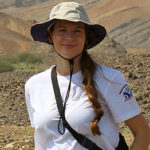
'Encrusting the mantle' by Marco Brenna
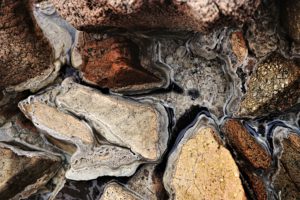
In January 2017, I joined a field expedition to Red Mountain, Mount Aspiring National Park, New Zealand. Red Mountain is the exposed portion of the Dun Mountain ophiolite belt, the place of origin of the name “dunite”, a rock consisting mostly of olivine. My colleague at the University of Otago, Dr. James Scott, is leading several projects dealing with the properties of and processes that occurred in the lithospheric mantle beneath New Zealand. I went along with him and one of his PhD students, Stephanie Junior, to sample portions of the mantle exposed high up in the Southern Alps. The landscape is rocky and, due to its chemical make-up (mostly Mg, Fe and Si), no vegetation covers the ground, resulting in a Martian-like red landscape. Because of its contrast, my eyes were drawn to a patch of white ground. With the thought in mind that New Zealand was once famed for its pink and white terraces, and hoping to discover something analogous, we explored the white patch, which however turned out to be “just” a carbonate spring. After the first, we found a few more of these springs, which occur along an alignment and are therefore likely controlled by some local fault that forms a pathway for fluid flow. Looking down on the ground, I saw a colourful combination of peridotite fragments encrusted with white carbonate, and snapped. The question remains, however, why a carbonate spring should occur within an ultramafic crustal domain?
About the author
Marco Brenna completed his PhD studies at Massey University (NZ) in 2012 on the magmatic development of Jeju Island (Korea). He has since held post-doctoral positions investigating other volcanic systems in Japan and Korea and New Zealand. He is currently a lecturer at the University of Otago researching broad aspects of intraplate alkaline volcanism from source melting to eruption.

'Hardness removal by crystal sticks' by David Benavente
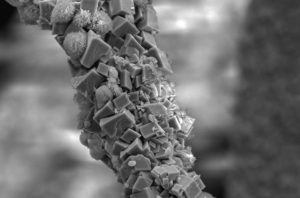
The electrochemical softening method precipitates calcite, aragonite and brucite crystals on a stainless steel wool cathode.
My colleagues from the Applied Electrochemistry group at my university suggested that I should study precipitates on stainless steel as they were investigating electrochemical softening methods to remove hardness from natural waters. This attempt seemed amazing and new for me, after having been studying salts in monuments and stalactites, etc., for a long time. I thought: “easy task, a bit ugly though”. I did not know what the scaling was like; what the precipitate that spoils my kettle or washing machine was like.
We characterised the precipitate using scanning electron microscopy with energy dispersive X-ray spectroscopy and X-ray diffraction. Simple is beautiful. Calcium and magnesium ions were eliminated in different mineral phases. Calcium is removed from water as calcite and aragonite, whereas magnesium is precipitated as brucite. The calcite presented trigonal shape crystals, the aragonite had needle forms whereas the brucite precipitated as spherulites. It was amazing how hardness could transform itself. All the crystal shapes seemed to be in a perfect balance, coexisting in harmony.
About the author
David Benavente is a member of the Applied Petrology Group and of the Department of Earth and Environmental Sciences, at University of Alicante. He is Associate Professor in Petrology and Geochemistry and his research involves low temperature geochemistry processes, mainly in salt crystallisation, gas-water-rock and karst systems; and petrophysics and durability of building stones; and conservation of historical and cultural heritage built in stone.

